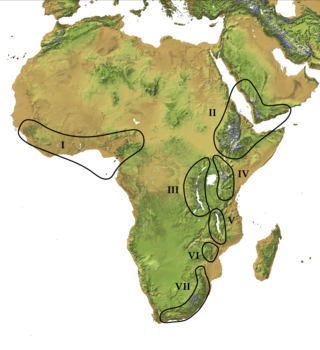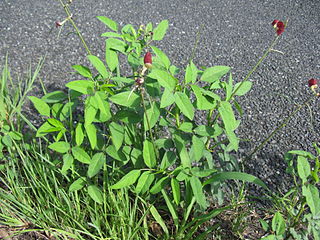
Myrrhis odorata, with common names cicely, sweet cicely, myrrh, garden myrrh, and sweet chervil, is a herbaceous perennial plant belonging to the celery family Apiaceae. It is the only species in the genus Myrrhis.

The Afromontane regions are subregions of the Afrotropical realm, one of the Earth's eight biogeographic realms, covering the plant and animal species found in the mountains of Africa and the southern Arabian Peninsula. The Afromontane regions of Africa are discontinuous, separated from each other by lower-lying areas, and are sometimes referred to as the Afromontane archipelago, as their distribution is analogous to a series of sky islands.

Alsophila capensis, synonym Cyathea capensis, is a regionally widespread and highly variable species of tree fern. It is indigenous to Southern Africa and South America.

Olea europaea subsp. cuspidata is a subspecies of the well-known olive tree, which until recently was considered a separate species and is still mentioned as such in many sources. Native to northeast of Africa and the drier parts of subtropical Asia, it has various common names, including wild olive, African olive, brown olive and Indian olive.

Protea welwitschii is a species of shrub or small tree which belongs to the genus Protea, and which occurs in bushveld and different types of grassland.

Senecio angulatus, also known as creeping groundsel and Cape ivy, is a succulent flowering plant in the family Asteraceae that is native to South Africa. Cape ivy is a scrambling and a twining herb that can become an aggressive weed once established, making it an invasive species. It has been naturalised in the Mediterranean Basin, where it is grown as an ornamental plant for its satiny foliage and sweet-scented flowers. Other names include climbing groundsel, Algerian senecio, and scrambling groundsel.

Forsskaolea tenacissima is a member of the non-stinging nettles genus Forsskaolea and is in the same family as the stinging kind, Urticaceae. Described as "looking like a tough character that does not want or need a caress", F. tenacissima makes its home where not many plant species survive, in stony soils, road edges, in the gravel wadi and "in the rock crevices and water-receiving depressions" above the stone pavements of the Hamadas.
Salvia disermas is a herbaceous perennial shrub native to South Africa, found in streambeds, moist forest, grassland, and disturbed ground. It was originally specified as rugosa, but was changed to disermas. It grows throughout west Africa, with its greatest concentration in South Africa, where it is used medicinally as a tea, and as a lotion for treating sores.

Kew Gardens is a botanic garden in southwest London that houses the "largest and most diverse botanical and mycological collections in the world". Founded in 1840, from the exotic garden at Kew Park, its living collections include some of the 27,000 taxa curated by Royal Botanic Gardens, Kew, while the herbarium, one of the largest in the world, has over 8.5 million preserved plant and fungal specimens. The library contains more than 750,000 volumes, and the illustrations collection contains more than 175,000 prints and drawings of plants. It is one of London's top tourist attractions and is a World Heritage Site.

Aloiampelos commixta is a flowering plant in the Asphodelaceae family. It is commonly called Table Mountain aloe, and is a rare succulent plant that is endemic to the Cape Peninsula, South Africa. It naturally occurs only on the Table Mountain range, within the city of Cape Town.

Euphorbia caput-medusae is a plant of the genus Euphorbia that occurs in and around Cape Town, South Africa.

Vachellia flava, synonym Acacia ehrenbergiana, is a species of drought-resistant bush or small tree, commonly known as salam in Arabic. It is found in the Sahara, the northern Sahel, parts of East Africa, the Arabian Peninsula and Iran.

Scadoxus multiflorus is a bulbous plant native to most of sub-Saharan Africa from Senegal to Somalia to South Africa. It is also native to Arabian Peninsula and to the Seychelles. It is naturalized in Mexico and in the Chagos Archipelago.It is also found in Indian peninsula. It is grown as an ornamental plant for its brilliantly coloured flowers, either in containers or in the ground in where the climate is suitable. There are three recognized subspecies. Strongly toxic like other Scadoxus species, it has been used as a component of arrow poisons and fishing poisons, as well as in traditional medicine. Common names, some of which are used for other species, include blood lily, ball lily, fireball lily, blood flower, Katherine-wheel, oxtongue lily, poison root and powderpuff lily.

Scadoxus membranaceus is a flowering plant in the Amaryllidaceae family. It is a bulbous plant from South Africa. The smallest of the species of Scadoxus, it is sometimes cultivated as an ornamental plant where a minimum temperature of 5 °C (41 °F) can be maintained.

Phyllanthus tenellus is a herbaceous plant in the leafflower family, Phyllanthaceae. It is commonly called Mascarene Island leaf flower as it is native to the Mascarene Islands. It is often a weed in flower beds, gardens, roadsides, and other disturbed areas.

Melhania ovata is a plant in the family Malvaceae.
Melhania velutina is a plant in the family Malvaceae, native to Africa and the Arabian Peninsula.
Orbivestus cinerascens is a plant in the family Asteraceae.

Macroptilium lathyroides is a species of plant in the legume family (Fabaceae) commonly known as the phasey bean. It is the type species of genus Macroptilium. Herbaceous annual or short-lived perennial growing up to 1 m high, it is native to the tropical and subtropical areas of Central and South America, and naturalized throughout the tropics. It is cultivated for forage or as a green manure or cover crop in rotation. As it quickly spreads on disturbed soils, it is considered an environmental weed in some areas.

Hewittia malabarica is a flowering plant in the monotypic genus HewittiaWight & Arn., belonging to the family Convolvulaceae and widespread throughout tropical Africa, Asia, and Polynesia. It is a climbing or prostrate perennial herb with slender stems and flowers that are pale yellow, cream, or white with a purple center, and large leaves that can be used as a cooked vegetable or used in folk medicine with the roots. The stems can be used to make ropes.

















